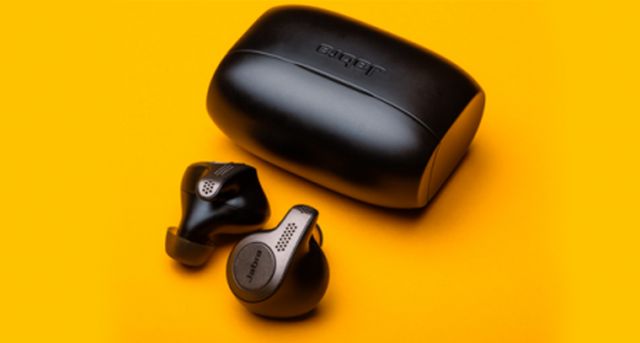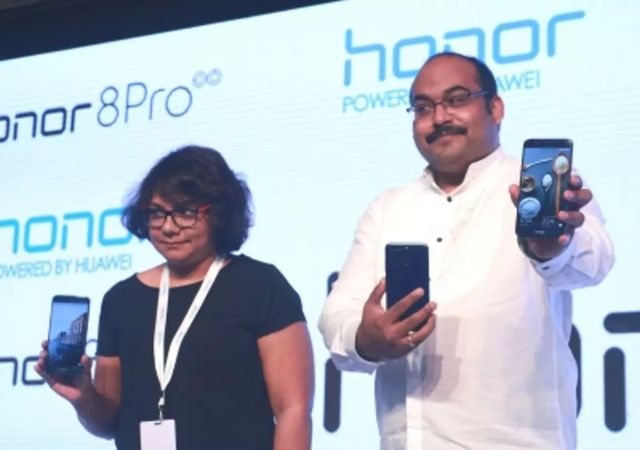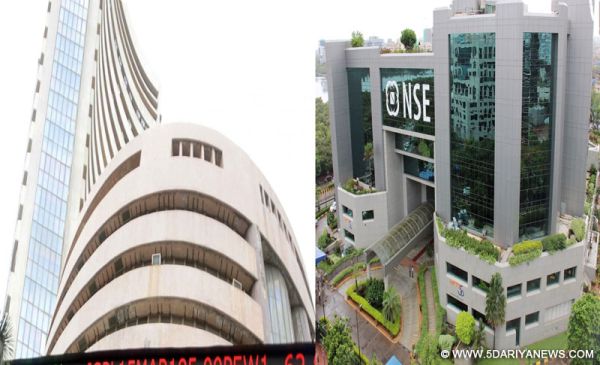
by admin | May 25, 2021 | Branding, Business, Markets, Medium Enterprise, SMEs, Technology
 By Krishna SinhaChaudhury,
By Krishna SinhaChaudhury,
New Delhi : Wire-free listening has its own perks and Apple’s AirPods (Rs 15,400) and Bose SoundSport Free (Rs 18,990) cord-free earbuds have ruled the roost in the Indian market.
Not any more.
Denmark-based Jabra, a subsidiary of GN Netcom that makes in-ear and on-ear audio wearables, is now offering Jabra “Elite 65t” wireless in-ear headphones for just Rs 12,999.
Is it worth given the price? Let’s find out.
At first glance, the Elite 65t looks promising. The earbuds are all black with gunmetal gray accents to add some flash to an otherwise understated design.
A good thing about the buds is that these do not stick out from the ears. There are no “long stems” either that hang close to earlobes like the ones we see in the Apple AirPods.
The company has included silicone tips in three different sizes that offer a good amount of noise isolation and a secure fit.
The tips had no wings to hold the device in place but they stayed secure in our ears. Using the largest buds gives a tight fit which is crucial to maximising bass.
We also found the buds to be quite capable in handling sweat and dust.
A charging case is included in the package that is slightly bigger than the one provided with AirPods. A good thing is despite being slightly larger, it remains a pocketable case.
The charging case is durable despite being made of plastic and could handle rough usage. A clasp in the front secured the case and ensured the headphones do not come off easily.
The earbuds lasted close to five hours on a single charge and the case added close to 10 hours of battery life to Jabra Elite 65t.
A neat feature is that pulling out one of the earbuds stops the music automatically. It starts playing again once plugged back into the ear.
We also found it easy to toggle through tracks just by holding down the volume up and down buttons on the left eartip.
The earbuds delivered quality sound — clarity and volume in all conditions. Both the eartips feature a microphone area that stick slightly towards the mouth to pick up the sound.
The microphones built into each bud filtered out ambient noise, such as wind, during the test calls.
What does not work?
We found the noise-isolating fit too tight and some may find it uncomfortable.
The fit can also cause slight pain if worn for long periods.
Conclusion: The Jabra Elite 65t offers great audio packaged in a durable and good-looking in-ear device, offering good overall music and call quality. If you are looking for a cheaper alternative to AirPods, we would recommend this device that also beats the AirPods in many ways.
(Krishna SinhaChaudhury can be contacted at krishna.s@ians.in)
—IANS

by admin | May 25, 2021 | Business, Large Enterprise, Markets, Technology
 By Nishant Arora,
By Nishant Arora,
New Delhi : You must have noticed Virtual Reality (VR) stations tucked away in a corner at your neighbourhood mall that require kids to wear head-mounted devices (HMDs) to experience an immersive world.
At the moment, for an Indian consumer, the ultimate 360 degree VR experience is either limited to those stations or headgear sold bundled with smartphones. But most of those HMDs are yet to evolve, even as VR developers aim to build high-quality games to drive more people towards the technology.
Despite arriving on the scene some two-three years back, mass-level VR impact is yet to be seen — both on the consumer and enterprise fronts — though things have slowly started picking up.
In the meantime, industry experts are giving Augmented Reality (AR) a definite edge over VR. Unlike VR, AR lets users continue to be in touch with the real world while interacting with the virtual world.
According to a new report from International Data Corporation (IDC), worldwide spending on AR/VR is forecast to reach $17.8 billion in 2018 — an increase of nearly 95 per cent over the $9.1 billion in 2017.
“VR and AR are disruptive technologies, but they will take years to emerge. There was a lot of buzz and hype in 2016 for AR with the ‘Pokemon Go’ craze — and with VR too, with Facebook saying VR was the next computing platform,” said Thomas Husson, Vice President and Principal Analyst, Forrester.
“In 2017, we saw more realism about the opportunities VR and AR will open up and, at the same time, more tools made available to developers to build new AR experiences with Apple’s ‘ARKit’ and Google’s ‘ARCore,’ ” Husson told IANS.
Although smartphone giant Apple is yet to shake up the AR/VR market, the company has introduced “ARKit” in iOS 11 — a new framework that allows developers to create unparalleled AR experiences for iPhones and iPads.
Google has also released a new software development kit (SDK) called “ARCore” that brings AR capabilities to the existing and future Android phones.
“Soon, there will be hundreds of millions of iOS compatible devices for Apple “ARKit” starting to create effects of scale and scope,” said Husson.
According to Thomas George, Senior Vice President and Head of CyberMedia Research (CMR), when it comes to India, AR/VR is still in the initial stages of adoption.
“However, the AR/VR market in India is expected to register a compounded annual growth rate (CAGR) of more than 50 per cent in the next five years,” George told IANS.
“Applications of AR/VR for headgear and mounted display are on the rise, particularly in sectors like retail, auto, health care, training, defence, gaming and entertainment — areas that are at the forefront of AR/VR adoption in the country,” George added.
In the consumer space, apart from Samsung Gear VR at Rs 7,290 which is still the leader, Xiaomi has launched Mi VR Play 2 (Rs 12,999) while Lenovo just unveiled a stand-alone VR headset “The Mirage Solo” — housing motion-tracking technology on the VR platform of Google Daydream (itself an excellent standalone VR device) — at CES 2018.
In the AR/VR arena, the big devices that are making news are Microsoft Hololens, Oculus Rift and HTC Vive.
“I think AR will grow much faster than VR since it will be powered by the scale of smartphones and is a more natural extension of mobile behaviour, while VR requires some additional and expensive equipment,” Husson noted.
Some companies will rightly invest in VR for educational and training purposes, maintenance and productivity improvements to help consumers try complex and expensive products.
“AR will start in the gaming and social space but will gain traction among traditional brands (consumer electronics, home equipment, furniture, etc),” Husson predicted.
According to George, AR/VR will also play a key role in areas like research and development.
Immersive technologies like AR/VR in India will also have potential for industries like public safety as well as retail, real estate, entertainment and tourism.
“An AR platform can take us on a heritage trail that can help people access images, video and audio providing tourists a view of the place and its history,” George added.
A rising number of consumer electronics applications such as gaming and entertainment are witnessing adoption of AR and VR devices as smartphone penetration continues to rise (India has over 300 million smartphone users).
Applications like immersive learning and entertainment, especially high-quality games, on top of state-of-the-art affordable headsets could kick-start AR/VR adoption sooner, experts stressed.
(Nishant Arora can be contacted at nishant.a@ians.in)
—IANS

by admin | May 25, 2021 | Branding, Business, Large Enterprise, Marketing Basics, Markets, Technology

Huawei India-Consumer Business Group Vice-President Sales P Sanjeev at the launch
By Krishna SinhaChaudhury,
New Delhi : There are nearly 650 million mobile phone users in India — and over 300 million of them have a smartphone. For these users, Chinese players became the first choice this year as they launched devices with compelling features, thus dominating the budget and mid-range price segment in the country.
Chinese vendors captured 49 per cent of the Indian mobile phone handset market in the first quarter of 2017 — with a 180 per cent (year-on-year) revenue growth — threatening to wipe out domestic players from the overall handset segment.
Among the top Chinese brands, Xiaomi witnessed the biggest growth this year.
With a market share of 23.5 per cent and having shipped 9.2 million smartphones in the third quarter this year, Xiaomi became the fastest-growing smartphone brand with a growth rate of nearly 300 per cent (year-on-year) in the third quarter this year.
According to IDC, Samsung had 23.5 per cent market share in India, similar to Xiaomi, the Lenovo-Motorola combine was at 9 per cent, Vivo at 8.5 per cent and OPPO at 7.9 per cent.
For Xiaomi, its Redmi Note 4 device that was launched in January at Rs 9,999 for the base model (2GB RAM and 32GB onboard storage) proved to be a game-changer and its best-selling smartphone too. The company shipped approximately four million units of the device in this quarter, said IDC.
Chinese brands like Huawei (which sells its youth-centric sub-brand Honor in India), Vivo, Motorola (a Lenovo brand) and OPPO’s performance remained strong and contributed to more than half of the total smartphone shipments in the country.
Aiming to push its position up in the highly competitive Indian market, Honor launched flagship products at “unbeatable prices”, like the highly-successful Honor 8 Pro (Rs 29,999) and Honor 7X (starting at Rs 12,999).
Vivo and OPPO’s aggressive marketing spends also paid them hefty dividends. With smartphone growth nearing saturation in metros, Chinese players were also busy building their base in the tier II and III cities.
When it comes to manufacturing in India, Xiaomi announced its third plant in the country based out of Noida and the first facility for power banks in partnership with Hipad Technology.
Spread across 230,000 square feet, the Noida unit is a dedicated facility for Xiaomi power banks where the Mi Power Bank 2i will be assembled. The company already has two smartphone manufacturing plants in Sri City, Andhra Pradesh, where more than 95 per cent of its smartphones sold in India are assembled locally.
Meanwhile, South Korean giant Samsung also announced that it would invest Rs 4,915 crore in expanding its Noida manufacturing plant to double the production capacity of both mobile phones and consumer electronics.
The Foreign Investment Promotion Board approved OPPO’s request to open single-brand retail stores in the country. With this decision, OPPO became the first smartphone company to get this opportunity in India.
The Chinese players also handled the post-demonetisation ripples well with high decibel marketing, increased credit line to distributors and efficient channel management.
Global vendors, led by Samsung, were able to withstand the aggressive Chinese players post-demonetisation owing to their good distributor coverage and penetration in the Indian market.
Aiming to gain a further foothold in the offline smartphone market, Xiaomi opened its first “Mi Home” store in Bengaluru in May and plans to add 100 such stores in the next two years.
Similarly, Lenovo-owned Motorola opened six “Moto Hubs” in Delhi-NCR and Mumbai and plans to open 50 more by the end of this year.
Huawei’s sub-brand Honor announced opening four more exclusive service centres in Kolkata, Hyderabad, Lucknow and Guwahati. Its service centres are already operating in 17 cities.
India this year surpassed the US to become the second-largest smartphone market in the world after China. Yet, according to Counterpoint Research, only one fourth of India’s population uses smartphones, thus making the country an attractive destination for Chinese players in the mobile ecosystem.
Highlights:
* Chinese vendors captured 49 per cent of the Indian mobile phone handset market in the first quarter of 2017.
* Among the top Chinese brands, Xiaomi witnessed the biggest growth this year.
* South Korean giant Samsung announced it would invest Rs 4,915 crore in expanding its Noida manufacturing plant.
* The Foreign Investment Promotion Board approved OPPO’s request to open single-brand retail stores in the country.
* Xiaomi announced its third manufacturing plant in the country based out of Noida and the first facility for power banks in partnership with Hipad Technology.
(Krishna SinhaChaudhury can be contacted at krishna.s@ians.in)
—IANS

by admin | May 25, 2021 | Business, Economy, Emerging Businesses, Markets, News, SMEs
 Mumbai : With cafes in over 32 countries from Malaysia to Australia to Dubai, International coffee chain Papparoti has now opened doors in Mumbai and according to the spokesperson, the huge potential in Indian market makes it a perfect fit especially because of the culture of “bun and tea”.
Mumbai : With cafes in over 32 countries from Malaysia to Australia to Dubai, International coffee chain Papparoti has now opened doors in Mumbai and according to the spokesperson, the huge potential in Indian market makes it a perfect fit especially because of the culture of “bun and tea”.
“We see huge potential for the brand to be successful in India primirily because it identifies with our culture of bun and chai. Also we would see a lot of Indians at Papparoti cafe in Dubai and thought why not give them the taste of Papparoti in their city,” Nitin Jethwani, co-founder of the brand in cities like Mumbai, Hyderabad, Pune Chennai and Bengaluru along with Kunal Jethwani, told IANS.
The co-partner of the outlet in the above mentioned cities is Suraj Bahirwani.
Papparoti is known for their delicious buns, variety of coffee and beverages.
Launched first in Malaysia in 2003, the brand has a presence all over the world, with 407 outlets and kiosks across Malaysia, Dubai , Indonesia, UK, Australia,China, Vietnam, Abu Dhabi, Kuwait, Saudi Arabia, UAE, Oman, Bangladesh and now in India.
Nitin further said that “Indian is the second highest consumer market globally and if one connects with a brand there seems to be no limit.”
“Indian F&B has evolved drastically in the past few years. We see so many international QSRs who have been well received in India,” he said and added that they “see a great story of the brand in India.”
“In the next quarter we plan to target cities like Chennai( scheduled to open in late January 2018 and Bengaluru. We are also in talks with airports of various cities for our brand,” he said.
—IANS

by admin | May 25, 2021 | Banking, Economy, Markets, News
 By Rohit Vaid,
By Rohit Vaid,
Mumbai : The central bank’s upcoming monetary policy review, combined with the direction of foreign fund flows are expected to drive investors’ sentiments in the equity markets in the coming week.
Market observers opined that other factors such as the rupee’s movement against the US dollar, global crude oil prices and further economic reforms will impact investors’ risk-taking appetite.
“RBI is scheduled to meet on December 6, 2017, and is expected to leave interest rates unchanged as inflation is inching up due to firming crude oil prices, increased financial market volatility and fiscal issues,” D.K. Aggarwal, Chairman and Managing Director of SMC Investments & Advisors, told IANS.
“Nifty is expected to trade in the range of 10,000-10,300 points levels, whereas Bank Nifty is expected to trade between 24,900-25,600 points levels.”
On technical levels, Deepak Jasani, Head – Retail Research, HDFC Securities, predicted a continued “short-term downtrend” for the Nifty after four consecutive sessions of correction.
“Nifty could now head towards the next supports of 10,050-10,094 points early next week,” Jasani said.
“Further downsides are likely if these supports fail to hold. Any pullback rallies could find resistance at 10,230 points.”
In its last review, the RBI had kept the key lending rate unchanged.
According to Devendra Nevgi, Founder and Principal Partner, Delta Global Partners, apart from the RBI’s rate decision, investors will also look to the language and cues on the future inflation scenario.
“Though the consensus is that RBI may not cut the repo rates, the language needs more attention if RBI turns more hawkish on sustained inflation and how the members’ votes split,” Nevgi told IANS.
Macro-data — Nikkei Services PMI — along with passenger vehicle sales will also determine the trajectory of the key indices on Monday, December 4.
Besides the macro-economic data points, volatility in the rupee’s movement against the US dollar and the direction of foreign fund flows could make investors nervous.
On the currency front, the rupee on Friday strengthened by 23 paise to close at 64.47 against the US dollar.
“Next week, the US dollar may react positively to the news that US Senate has approved the tax bill,” Anindya Banerjee, Deputy Vice President for Currency and Interest Rates with Kotak Securities, told IANS.
“As a result, USD/INR may inch higher towards 64.70-80 levels on spot with 64.30-35 acting as strong support. A range of 64.30 to 64.80 is expected over the near term.”
In terms of investments, provisional figures from the stock exchanges showed that foreign institutional investors (FIIs) offloaded stocks worth Rs 2,772.56 crore during the week ended November 27-30.
Last week, continuous outflows of funds, along with growing concerns over the country’s widening fiscal deficit as well as rising crude oil prices pulled the two key equity indices — S&P BSE Sensex and NSE Nifty 50 — lower.
Consequently, the barometer 30-scrip Sensex of the Bombay Stock Exchange (BSE) plunged 846.3 points, or 2.51 per cent to 32,832.94 points.
Similarly, the broader Nifty 50 of the National Stock Exchange declined by 267.9 points, or 2.58 per cent, to close at 10,121.80 points.
(Rohit Vaid can be contacted at rohit.v@ians.in)
—IANS





